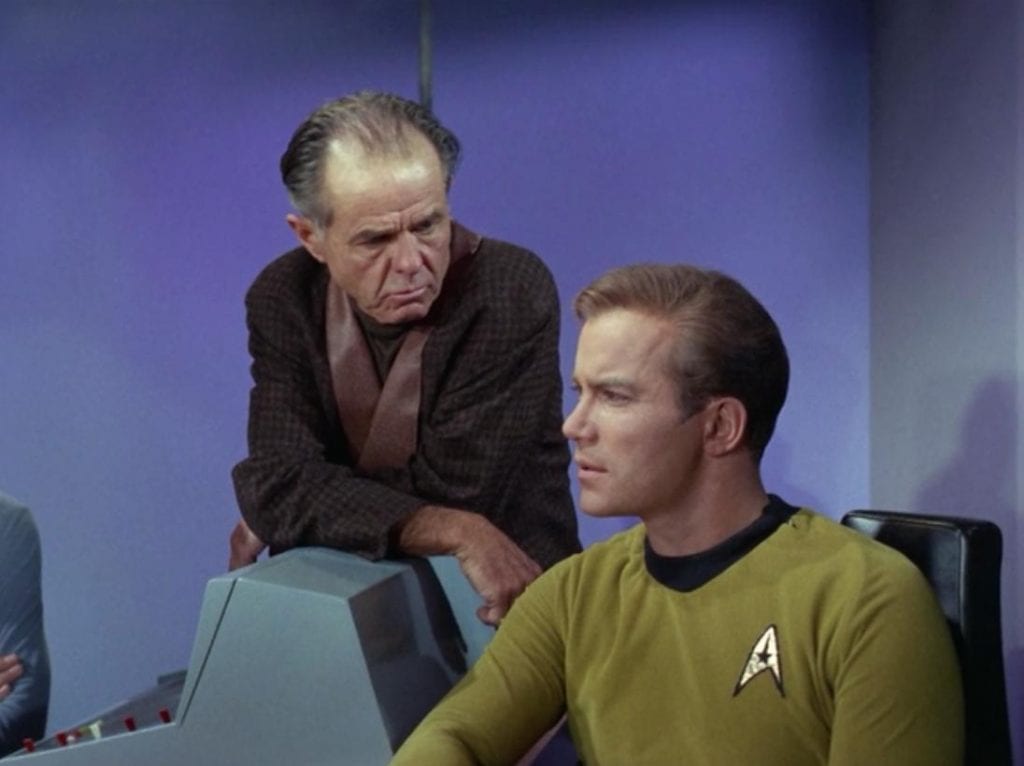Combining the legal profession with newfangled modernities like computers? Legal automation and digitization of legal processes has drawn its fair share of doubt and pushback over the decades. Even in, of all things, an old episode of Star Trek.
Back in the Sixties when William Shatner first wore the captain’s stripes on the good ship Enterprise, he was put on trial in an episode named “Court Martial.” Accused of negligence costing a crewman his life, Captain Kirk was represented by a craggy Luddite named Samuel L. Cogley, played by film noir immortal Elisha Cook, Jr.

The character was reasonably a stand-in for many viewers who had their doubts about the advent of the so-called “thinking machines.” Cogley relied on old-fashioned books, as they were “where the law is,” not in the soulless memory banks of computers. During one scene, he implores the court to act “in the name of a Humanity fading in the shadow of the machine.”
The starship’s computer ends up being complicit in the plot’s skullduggery – but only because it had been reprogrammed to frame Kirk for the crime. Still, the story reinforced the idea that the law, like other professionals, occupied a place too exalted to be tampered with through the intrusion of machines.
As has been pointed out before, lawyers are naturally disposed to be conservative. You can imagine how some of them react when confronted with stories about Silicon Valley entrepreneurs who think there’s a business case for replacing human professionals with robo-lawyers. Because, as one put it, “Everyone knows this is the future of the legal practice. I don’t want to spend the second half of my career like a taxi driver complaining about Uber.”
Frank Levy, a professor emeritus at MIT, has his doubts. “Ninety percent of what lawyers do today cannot be automated,” he claims, as the law demands intellectual skills beyond today’s technology.
The thing is, they’re both right. It’s a matter of which aspects of the legal profession you’re looking at.
Leaving the mundane to machines
Legal Operations, as defined by Connie Brenton, encompasses 12 core competencies that “every legal department must manage to have a disciplined, efficient, and effective legal function,” as she puts it. As in any business, accomplishing those functions relies on processes and a level of routinization that doesn’t allow for the exercise of innovation or intelligence.
Many of these processes are rote and repetitive work, but absolutely necessary, and aren’t restricted to underlings. The “intellectual workers” who drive so much value for a Legal Ops team and the enterprise are often not engaging their intellects very much at all. Experienced attorneys get caught up in mundane vettings, check-offs, document routings, and other tasks. These deplete the time and energy they could be spending at the “ninety percent” of true lawyering referred to by Levy.
If an NDA process is automated, you may have eliminated a lawyer’s need to oversee what’s now a standardized and dependable digital workflow. But it also means s/he can apply themselves to putting professional brainpower to work elsewhere. Rather than turn the legal profession into an implacable assembly line, legal automation can add a greater level of humanity to the practice of law in at least four ways we can rattle off right away…
1. By giving ‘bureaucracy’ a beatdown
When a legal department is perceived as a bottleneck or choke point within the enterprise, it’s hard to be perceived as a go-to partner for adding value to programs. The problem is one of responsiveness – people’s main gripe about “bureaucracy,” whether in business or government, is about the lack thereof. They’re willing to follow the rules and be compliant, but the slog to get there? It’s what drags down the reputation of the legal department.
Manual processes are the major culprit. Need proof? Automating an NDA process can result in end-to-end execution in 1/20th the time as traditional processes. Being that responsive shows your focus is squarely on satisfying the client’s need, not on honoring processes above people.
Another failure of bureaucracy? The inability to adapt to specific situations, or personalize to the needs of the few. Legal automation using a state-of-the-art workflow automation solution provides a high degree of flexibility in creating workflows customized to your clients’ precise demands, while still maintaining compliance.
2. By energizing idea & innovation generation
We couldn’t put it better than Justin Hectus of CLOC and Keesal, Young & Logan did: “The best ideas come from the people who do the work, and just opening the door to them about the possibility of change and improvement provides a level of engagement and accountability that people frankly crave in their jobs and professional lives.”
Those same people get deeply and enthusiastically engaged with the possibilities of legal automation technology. They quickly grasp its potential to enhance how they do their jobs.
It’s why so many of the fresh ideas and new ways to deploy legal automation we discover for TAP don’t come from us, but from Legal Operations clients. They’ve had the chance to open up a dynamic new toolbox – or maybe toybox is a better way to say it, because there’s an element of play and invention in what they do.
Eliminating rote, soul-deadening processes? Giving people ways to innovate and create new approaches to their work? It’s how we can tap into the most human wellspring of all, their creativity in solving even the knottiest problems.
3. By empowering a culture of collaboration
People thrive when they’re able to partner and collaborate with colleagues and co-workers. We’re social animals, and the workplace and how we do the work within it are no exceptions.
When legal automation technologies are used to enable better collaboration – between teammates, Legal Ops and clients, with outside counsel, or any combination thereof, it improves the quality of the process and the work product.
As Deloitte has noted, relieving employees of rote, routine tasks actually improves employee morale. A bot or automated workflow may have taken over a human being’s job, but that person gets to expand his or her horizons. How? By working more closely and effectively with the others who are tackling the same project or challenge. It’s a paradigm we’ve seen repeatedly at legal automation adopters. Technology lubricates teambuilding and collaboration, often in ways a Legal Ops department or the enterprise it serves had never anticipated.
4. By giving more clients more access to better services
Legal automation allows legal e-forms and processes to be available 24/7 for users, whether they’re Legal Ops’ corporate stakeholders or a law firm’s clients. That’s one way of improving access on the corporate front, among many other benefits.
Yet legal automation also brings down the costs of legal services for those who have previously been unable to take advantage of legal services, opening up access to people who often need these services the most.
In either case, legal automation proves its worth by allowing Legal Ops, law firms, even storefront practitioners serving the underserved to deliver more legal expertise to their clients. In the end, that’s the “humanization” of legal processes and services that matters most, isn’t it?
Even Sam Cogley couldn’t argue with that.


